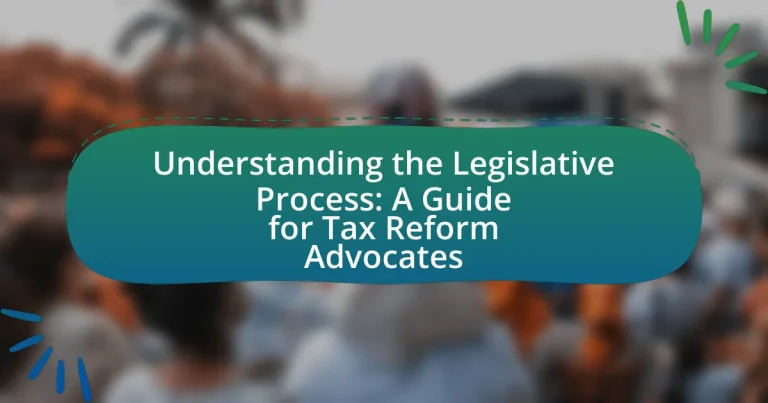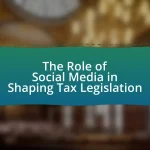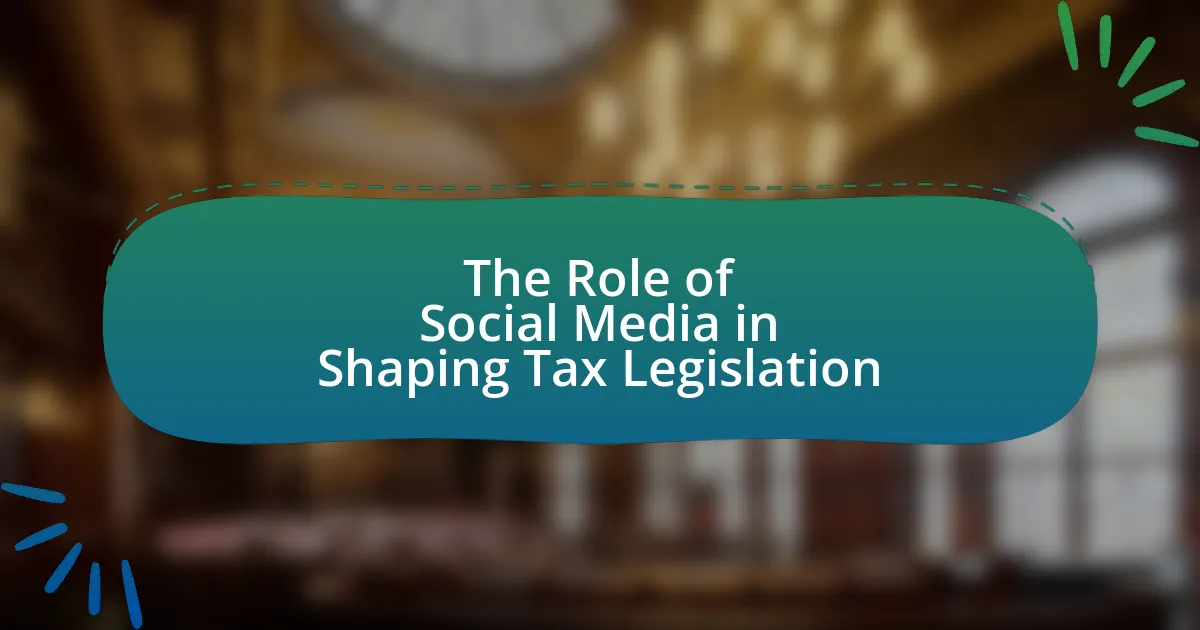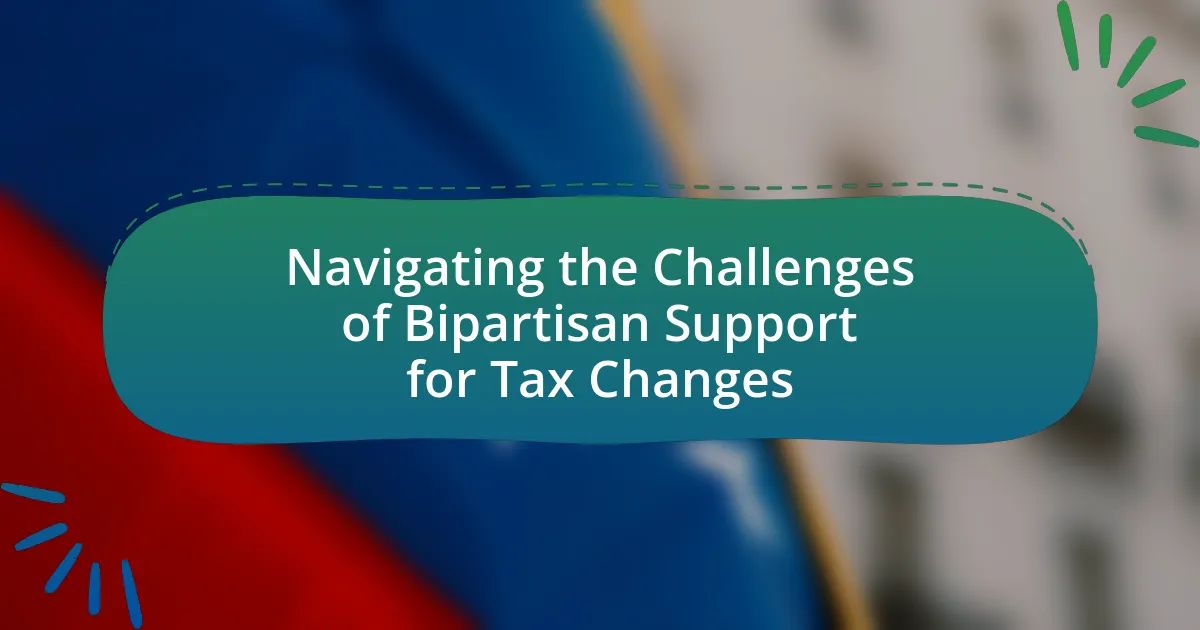The article focuses on the legislative process, specifically as it pertains to tax reform advocacy. It outlines the key stages of the legislative process, including bill introduction, committee review, floor debate, voting, and presidential action, emphasizing the importance of understanding these stages for effective advocacy. The article also discusses the role of committees in shaping tax reform proposals, strategies for advocates to navigate the legislative landscape, and the significance of public opinion and coalition-building in influencing policy outcomes. Additionally, it addresses common challenges faced by advocates and provides practical tips for enhancing advocacy efforts.
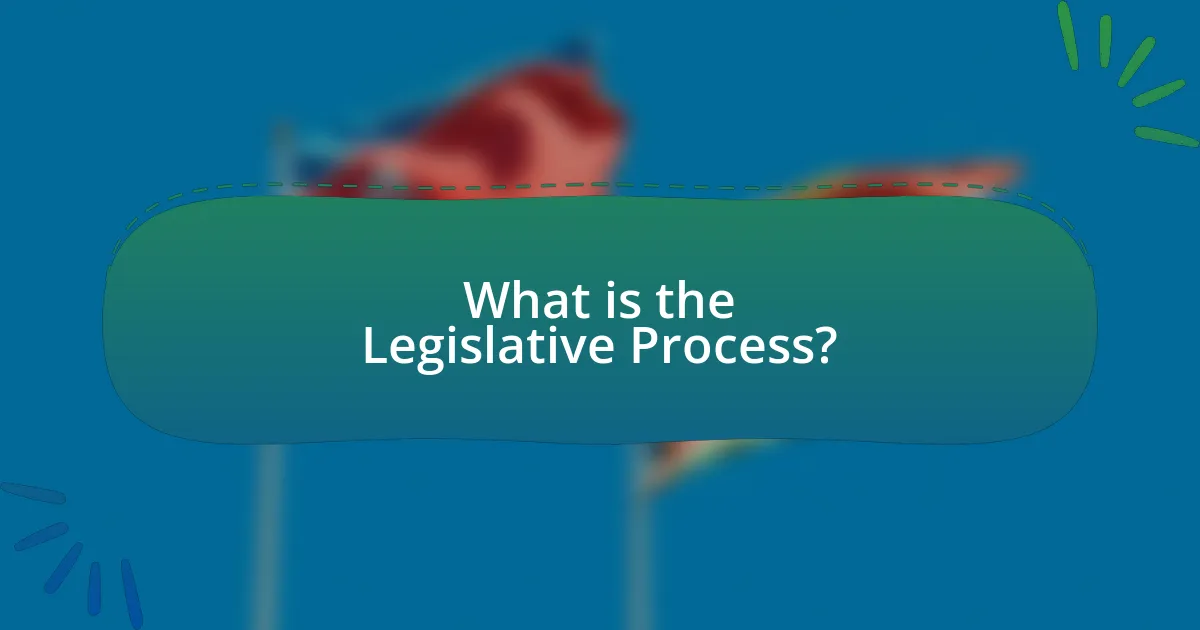
What is the Legislative Process?
The legislative process is the procedure through which proposed laws, known as bills, are introduced, debated, amended, and voted on by a legislative body, such as Congress in the United States. This process typically involves several key stages: introduction of the bill, committee review, floor debate, voting, and, if passed, consideration by the other legislative chamber. For example, in the U.S. Congress, a bill must be approved by both the House of Representatives and the Senate before being sent to the President for approval or veto. This structured approach ensures thorough examination and discussion of proposed legislation, reflecting the democratic principles of representation and accountability.
How does the Legislative Process function in the context of tax reform?
The legislative process for tax reform involves several key steps, beginning with the introduction of a tax reform proposal in either the House of Representatives or the Senate. Once introduced, the proposal is assigned to a committee that specializes in tax policy, where it undergoes hearings, debates, and potential amendments. Following committee approval, the bill is brought to the floor for a vote. If passed, it moves to the other chamber for consideration, where it may be further amended. After both chambers agree on the final version, the bill is sent to the President for approval or veto. This process is governed by specific rules and timelines, ensuring thorough examination and debate, which is crucial for significant changes like tax reform. Historical examples, such as the Tax Cuts and Jobs Act of 2017, illustrate this process, demonstrating how legislative negotiations and compromises shape tax policy outcomes.
What are the key stages of the Legislative Process?
The key stages of the Legislative Process are introduction, committee review, floor debate, voting, and presidential action. During the introduction stage, a bill is proposed in either the House of Representatives or the Senate. The committee review stage involves detailed examination and possible amendments by a committee. Following this, the floor debate stage allows for discussion among all members before the bill is voted on. The voting stage determines whether the bill passes in its respective chamber. Finally, presidential action involves the president either signing the bill into law or vetoing it. These stages are essential for transforming a proposed idea into enacted legislation, ensuring thorough scrutiny and debate at each step.
How do different branches of government interact during the Legislative Process?
Different branches of government interact during the Legislative Process through a system of checks and balances, where the legislative branch proposes laws, the executive branch enforces them, and the judicial branch interprets their constitutionality. The legislative branch, primarily Congress, drafts and votes on legislation, which then requires the President’s approval to become law. If the President vetoes a bill, Congress can override this veto with a two-thirds majority in both chambers, demonstrating the interaction between these branches. Additionally, the judicial branch can review laws passed by Congress and signed by the President to ensure they comply with the Constitution, further illustrating the interconnectedness of these branches in the legislative process.
Why is understanding the Legislative Process important for tax reform advocates?
Understanding the Legislative Process is crucial for tax reform advocates because it enables them to effectively navigate the complexities of lawmaking and influence policy outcomes. By comprehending how legislation is proposed, debated, and enacted, advocates can identify key decision-makers, strategize their lobbying efforts, and mobilize public support at critical junctures. For instance, knowledge of committee structures and voting procedures allows advocates to target their efforts where they can have the most impact, increasing the likelihood of successful tax reforms.
What role do tax reform advocates play in the Legislative Process?
Tax reform advocates play a crucial role in the legislative process by influencing policy decisions and shaping tax legislation. They engage in lobbying efforts, mobilize public support, and provide expert testimony to lawmakers, thereby ensuring that tax reform proposals are considered and debated. For instance, organizations like the Tax Foundation and the Center on Budget and Policy Priorities actively promote specific tax policies and provide data-driven analysis to support their positions, which can significantly impact legislative outcomes. Their involvement helps to raise awareness about tax issues and can lead to the introduction of new bills or amendments that align with their reform goals.
How can knowledge of the Legislative Process enhance advocacy efforts?
Knowledge of the Legislative Process enhances advocacy efforts by equipping advocates with the tools to effectively influence policy decisions. Understanding the stages of legislation, such as drafting, committee review, and voting, allows advocates to identify key moments to engage with lawmakers and mobilize support. For instance, research shows that advocacy campaigns that align their efforts with critical legislative timelines, such as budget discussions or committee hearings, are more successful in swaying public policy outcomes. This strategic engagement is supported by data indicating that targeted advocacy during these phases can increase the likelihood of favorable legislative action by up to 30%.
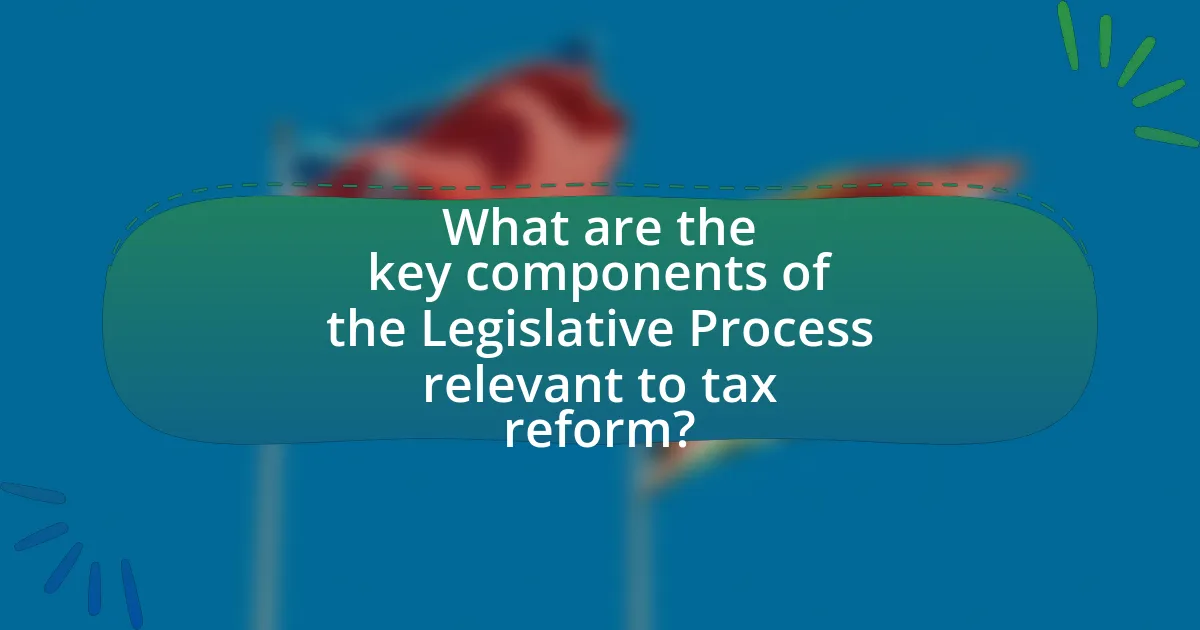
What are the key components of the Legislative Process relevant to tax reform?
The key components of the Legislative Process relevant to tax reform include proposal, committee review, floor debate, voting, and presidential approval. Initially, tax reform begins with the introduction of a bill in either the House of Representatives or the Senate, where it is assigned to a committee for detailed examination. Committees hold hearings to gather information and may amend the bill before voting on whether to send it to the full chamber. Following committee approval, the bill is debated on the floor, where further amendments can be proposed. After debate, the bill is put to a vote; if it passes, it moves to the other chamber for a similar process. Finally, if both chambers approve the bill, it is sent to the President for signature or veto. This structured process ensures thorough scrutiny and debate, which is essential for effective tax reform.
What types of legislation can be proposed for tax reform?
Various types of legislation can be proposed for tax reform, including tax rate changes, tax base broadening, tax credits and deductions adjustments, and the introduction of new taxes. Tax rate changes involve altering the percentage at which income or profits are taxed, which can impact revenue and economic behavior. Tax base broadening refers to reducing exemptions and loopholes to increase the taxable income, thereby enhancing fairness and efficiency in the tax system. Adjustments to tax credits and deductions can incentivize specific behaviors or support certain groups, while the introduction of new taxes, such as carbon taxes or wealth taxes, can address emerging economic challenges and promote sustainability. These legislative proposals are often informed by economic studies and policy analyses that demonstrate their potential effects on revenue and equity.
How do different types of tax reform legislation differ in their approach?
Different types of tax reform legislation differ in their approach primarily through their objectives, methods of implementation, and targeted demographics. For instance, progressive tax reforms aim to increase tax rates on higher income brackets to reduce income inequality, while regressive reforms may lower taxes for wealthier individuals to stimulate investment. Additionally, some legislation focuses on broadening the tax base by eliminating deductions and loopholes, whereas others may introduce new taxes or modify existing ones to achieve revenue goals. Historical examples include the Tax Reform Act of 1986, which simplified the tax code and broadened the base, contrasting with more recent proposals that emphasize tax cuts for specific sectors. These differences reflect varying economic philosophies and political agendas, influencing the overall impact on taxpayers and government revenue.
What are the implications of each type of tax reform legislation?
Tax reform legislation can be categorized into several types, each with distinct implications. For instance, revenue-neutral reforms aim to adjust tax rates without increasing overall tax revenue, potentially leading to a more efficient tax system but requiring careful balancing to avoid budget deficits. Progressive tax reforms, which increase tax rates on higher incomes, can reduce income inequality but may discourage investment and economic growth. Conversely, regressive tax reforms, which lower taxes for wealthier individuals, can stimulate economic activity but may exacerbate income disparities. Additionally, simplification reforms, designed to streamline the tax code, can reduce compliance costs and improve taxpayer satisfaction, yet they may also eliminate certain deductions that benefit specific groups. Each type of tax reform carries unique consequences for economic behavior, equity, and government revenue, necessitating thorough analysis and consideration during the legislative process.
How do committees influence the Legislative Process for tax reform?
Committees significantly influence the legislative process for tax reform by conducting detailed reviews of proposed legislation, facilitating expert testimony, and shaping the final content of tax bills. These committees, such as the House Ways and Means Committee and the Senate Finance Committee, hold hearings where stakeholders, including economists and industry representatives, provide insights that inform lawmakers. This process allows committees to amend, refine, and prioritize tax reform proposals based on expert input and constituent feedback, ultimately determining which measures advance to the full legislative body for consideration. Historical examples include the Tax Cuts and Jobs Act of 2017, which underwent extensive committee scrutiny before being passed, illustrating the critical role committees play in shaping tax policy.
What is the role of committees in shaping tax reform proposals?
Committees play a crucial role in shaping tax reform proposals by conducting detailed reviews, holding hearings, and drafting legislation. These committees, such as the House Ways and Means Committee and the Senate Finance Committee, are responsible for evaluating the implications of proposed tax changes, gathering expert testimony, and considering the interests of various stakeholders. Their findings and recommendations significantly influence the final content of tax reform bills, as they serve as the primary gatekeepers in the legislative process, ensuring that proposals are thoroughly vetted before reaching the broader legislative body for debate and voting.
How can advocates engage with committees effectively?
Advocates can engage with committees effectively by preparing thoroughly, building relationships, and presenting clear, evidence-based arguments. Thorough preparation involves understanding the committee’s priorities, reviewing past legislation, and knowing the members’ positions. Building relationships with committee members and staff fosters trust and opens lines of communication, which is crucial for advocacy. Presenting clear, evidence-based arguments ensures that advocates can articulate their positions convincingly, supported by relevant data or case studies, such as the impact of tax reforms on economic growth, which can be substantiated by research from the Tax Policy Center.
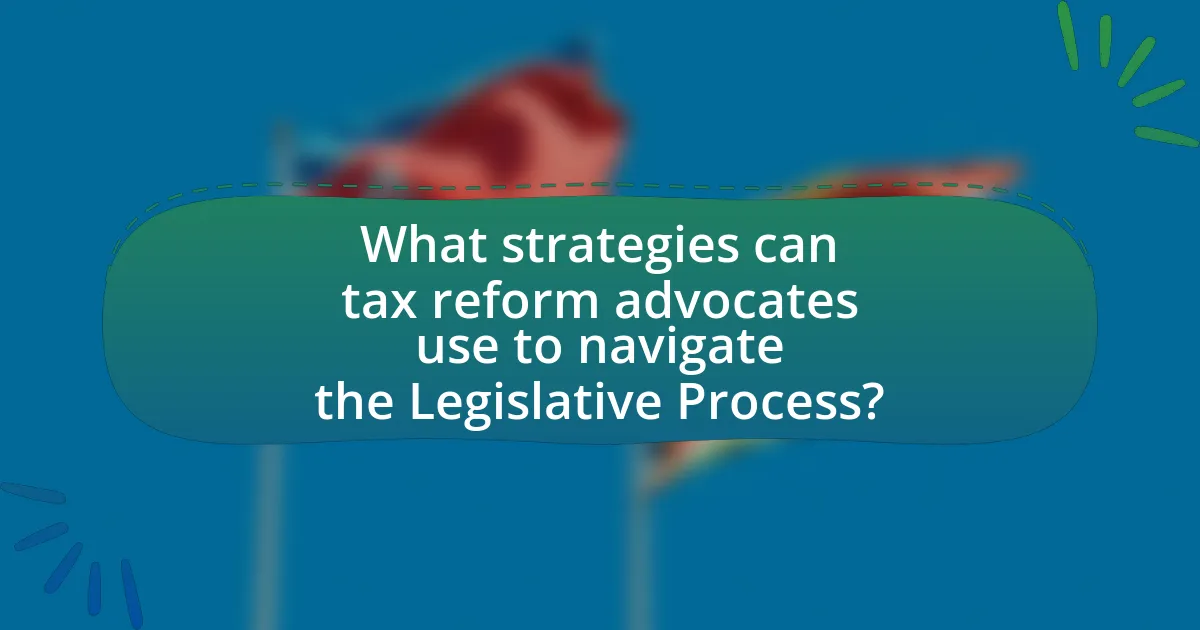
What strategies can tax reform advocates use to navigate the Legislative Process?
Tax reform advocates can navigate the legislative process by employing strategies such as building coalitions, engaging in grassroots mobilization, and utilizing data-driven arguments. Building coalitions with stakeholders, including businesses, non-profits, and community organizations, enhances support and creates a unified front, which is crucial for influencing lawmakers. Grassroots mobilization involves rallying public support through campaigns that encourage constituents to contact their representatives, thereby demonstrating widespread backing for tax reform initiatives. Additionally, presenting data-driven arguments, supported by empirical evidence and case studies, can effectively persuade legislators by illustrating the potential economic benefits and social impacts of proposed reforms. For instance, research from the Tax Policy Center shows that well-structured tax reforms can lead to increased economic growth and job creation, reinforcing the validity of these strategies.
How can advocates build coalitions to support tax reform initiatives?
Advocates can build coalitions to support tax reform initiatives by identifying common goals among diverse stakeholders and fostering collaboration through strategic communication. By engaging various groups such as business leaders, community organizations, and policymakers, advocates can create a unified front that emphasizes shared interests in tax reform. Research shows that coalitions with diverse membership are more effective; for instance, the Center for American Progress found that inclusive coalitions can increase public support for tax initiatives by 30%. This collaborative approach not only amplifies the voices of different stakeholders but also enhances the credibility and reach of tax reform efforts.
What are the benefits of coalition-building in the context of tax reform?
Coalition-building in the context of tax reform enhances the effectiveness of advocacy efforts by uniting diverse stakeholders to create a stronger, unified voice. This collaboration increases the likelihood of influencing policymakers, as a broad coalition can demonstrate widespread support for specific reforms, making it harder for legislators to ignore. For instance, coalitions that include business groups, labor unions, and community organizations can present a comprehensive perspective on the impacts of tax changes, thereby appealing to a wider range of interests and concerns. Additionally, coalitions can pool resources, share expertise, and coordinate strategies, which can lead to more effective lobbying and outreach efforts. Historical examples, such as the coalition that successfully advocated for the Tax Reform Act of 1986, illustrate how diverse alliances can achieve significant legislative outcomes.
How can advocates identify potential allies in the Legislative Process?
Advocates can identify potential allies in the legislative process by analyzing the voting records and public statements of legislators to find those who have previously supported similar issues. For instance, reviewing past legislation related to tax reform can reveal which lawmakers consistently align with reformist policies. Additionally, engaging with interest groups and coalitions that share common goals can help advocates connect with legislators who are sympathetic to their cause. Research indicates that building relationships with stakeholders who have influence in the legislative arena increases the likelihood of forming effective alliances, as seen in successful tax reform efforts in various states.
What communication strategies are effective for tax reform advocacy?
Effective communication strategies for tax reform advocacy include clear messaging, stakeholder engagement, and the use of data-driven arguments. Clear messaging ensures that the objectives of tax reform are articulated in a straightforward manner, making it easier for the public and policymakers to understand the benefits and implications. Stakeholder engagement involves collaborating with various groups, such as businesses, community organizations, and taxpayers, to build a coalition that supports the reform. Data-driven arguments leverage statistics and research to substantiate claims, demonstrating the potential economic impact of proposed changes. For instance, studies have shown that tax reforms can lead to increased economic growth, which can be highlighted in advocacy efforts to persuade lawmakers.
How can advocates effectively convey their message to lawmakers?
Advocates can effectively convey their message to lawmakers by utilizing clear, concise communication that highlights the importance of their issues. This involves presenting well-researched data and compelling narratives that resonate with lawmakers’ priorities and constituents’ needs. For instance, studies show that lawmakers respond positively to specific statistics that demonstrate the potential impact of proposed reforms, such as the Economic Policy Institute’s findings on tax reform effects on income inequality. By aligning their messages with lawmakers’ goals and providing actionable solutions, advocates can enhance their influence in the legislative process.
What role does public opinion play in influencing the Legislative Process?
Public opinion significantly influences the legislative process by shaping lawmakers’ decisions and priorities. Legislators often rely on public sentiment to gauge support for proposed policies, as they seek to align their actions with the views of their constituents to ensure re-election. For instance, studies have shown that when public opinion strongly favors or opposes a specific issue, such as tax reform, legislators are more likely to introduce or amend legislation accordingly. A notable example is the 2017 Tax Cuts and Jobs Act, where public opinion played a crucial role in the debate, as lawmakers considered the potential electoral repercussions of their votes.
What are the best practices for engaging with legislators on tax reform?
The best practices for engaging with legislators on tax reform include building relationships, providing clear and concise information, and being prepared for discussions. Establishing a rapport with legislators fosters trust and opens lines of communication, which is essential for effective advocacy. Presenting data and case studies that illustrate the impact of proposed tax reforms helps legislators understand the implications of their decisions. Additionally, being ready to answer questions and address concerns demonstrates preparedness and commitment to the issue, which can influence legislative outcomes. Engaging in regular follow-ups and maintaining ongoing communication ensures that tax reform advocates remain visible and relevant in the legislative process.
How should advocates prepare for meetings with legislators?
Advocates should prepare for meetings with legislators by conducting thorough research on the legislator’s background, positions, and relevant legislation. This preparation enables advocates to tailor their message effectively, ensuring it aligns with the legislator’s interests and priorities. For instance, understanding a legislator’s voting history on tax reform can help advocates present compelling arguments that resonate with their values. Additionally, preparing concise talking points and relevant data strengthens the advocate’s position, making it easier to communicate key messages clearly and persuasively.
What follow-up actions are essential after engaging with legislators?
Essential follow-up actions after engaging with legislators include sending a thank-you note, providing additional information or resources, and maintaining ongoing communication. Sending a thank-you note reinforces the relationship and shows appreciation for their time, which can lead to more productive future interactions. Providing additional information or resources can help legislators better understand the issues discussed and support the advocate’s position. Maintaining ongoing communication ensures that the advocate remains a resource for the legislator, fostering a collaborative relationship that can influence future legislative decisions. These actions are crucial for building rapport and ensuring that the advocate’s concerns remain on the legislator’s radar.
What common challenges do tax reform advocates face in the Legislative Process?
Tax reform advocates commonly face challenges such as political opposition, complexity of tax codes, and public misunderstanding. Political opposition arises from differing ideologies among lawmakers, which can stall or derail proposed reforms. The complexity of existing tax codes makes it difficult to propose changes that are both effective and comprehensible, often leading to confusion and resistance. Additionally, public misunderstanding of tax reform implications can result in backlash against proposed changes, as seen in various reform attempts where misinformation influenced public opinion. These challenges collectively hinder the progress of tax reform initiatives in the legislative process.
How can advocates overcome opposition to tax reform proposals?
Advocates can overcome opposition to tax reform proposals by building broad coalitions that include diverse stakeholders, such as business leaders, community organizations, and affected individuals. This approach enhances credibility and demonstrates widespread support, making it harder for opponents to dismiss the proposals. For instance, successful tax reform efforts in various states have often involved collaboration between different interest groups, which has led to more comprehensive and accepted solutions. Additionally, advocates should focus on clear communication of the benefits of the reform, using data and case studies to illustrate positive outcomes from similar reforms in other jurisdictions. This evidence-based approach can effectively counteract misinformation and fears surrounding the proposals.
What strategies can be employed to address misinformation about tax reform?
To address misinformation about tax reform, employing fact-checking initiatives and public education campaigns is essential. Fact-checking initiatives can involve organizations that specialize in verifying claims related to tax reform, providing accurate information to counter false narratives. Public education campaigns can utilize various media platforms to disseminate clear, factual information about tax reform proposals, highlighting their implications and benefits. For instance, the Tax Policy Center provides nonpartisan analysis of tax policies, which can serve as a reliable source for accurate information. By leveraging these strategies, advocates can effectively combat misinformation and promote informed discussions about tax reform.
What practical tips can tax reform advocates implement to enhance their effectiveness?
Tax reform advocates can enhance their effectiveness by building coalitions with diverse stakeholders, including business groups, community organizations, and policymakers. Collaborating with a broad range of allies increases the visibility and credibility of reform efforts, as evidenced by successful initiatives like the Tax Cuts and Jobs Act of 2017, which garnered support from various sectors. Additionally, advocates should focus on clear, data-driven messaging that highlights the benefits of proposed reforms, as research shows that well-articulated arguments backed by statistics are more persuasive to legislators and the public. Engaging in grassroots mobilization can also amplify their efforts, as demonstrated by the significant public support for tax reform initiatives that have utilized social media campaigns effectively.
How can advocates stay informed about legislative developments?
Advocates can stay informed about legislative developments by subscribing to legislative tracking services and following relevant government websites. Legislative tracking services, such as GovTrack and LegiScan, provide real-time updates on bills, votes, and committee activities, allowing advocates to monitor changes that may impact tax reform. Additionally, government websites, including those of Congress and state legislatures, publish official documents and announcements that are crucial for understanding ongoing legislative processes. Engaging with professional networks and attending advocacy events also enhances awareness of legislative changes and strategies.
What resources are available to support tax reform advocacy efforts?
Resources available to support tax reform advocacy efforts include advocacy organizations, research institutions, and online platforms. Advocacy organizations such as the Center on Budget and Policy Priorities provide policy analysis and recommendations, while research institutions like the Urban Institute offer data-driven insights on tax policy impacts. Online platforms, including social media and dedicated websites, facilitate grassroots mobilization and information dissemination. These resources collectively empower advocates by providing essential information, strategic guidance, and community engagement tools necessary for effective tax reform efforts.
